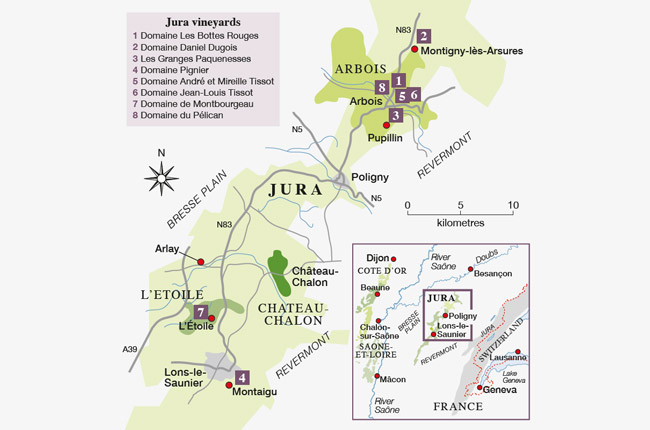The Arbois wine area is a fascinating place where winemaking customs have been refined over generations, and it is tucked away in the charming Jura Mountains of eastern France. Arbois, a charming region that has quietly established a reputation for producing distinctive wines with a flavour as unique as the land they originate from, is frequently eclipsed by more well-known French wine regions like Bordeaux or Burgundy.

Because of its long winemaking history and stunning natural surroundings, the Arbois region is proud to be the first regulated designation of origin (AOC) in the Jura. Dense forests, limestone cliffs, pastoral farming, and rolling hills covered in vines all contribute to the region’s distinctive terroir.
It is necessary to respect the land to comprehend Arbois’s wines. Arbois’s terroir is a complicated patchwork of soils, topographies, and microclimates that results in unique, character-driven wines. With a geological past spanning millions of years, the area is situated on top of ancient Jurassic limestone and marl. Because it controls water drainage and supplies a variety of minerals that give the grapes nuanced but captivating flavours, this soil composition is crucial for vine health.
Due to its continental climate, the region experiences frigid winters and scorching summers. The Jura Mountains’ moderating influence, which helps protect vineyards from strong winds and promote gradual grape ripening, is another advantage of Arbois.
As a result, Arbois produces wines with a depth of flavour and balanced acidity, which have made it a destination for discriminating wine enthusiasts.
The Arbois Grapes: A Reflection of the Terra
With a few grape varieties that flourish in the region’s demanding yet rewarding circumstances, Arbois is renowned for producing both red and white wines. The primary Arbois grapes are:
Savagnin: Known as the crown jewel of Jura, Savagnin is the star of Vin Jaune, Arbois’s most iconic wine. It flourishes in soils that are rich in limestone, yielding wines that are rich in nutty flavour, have a mineral richness that embodies the terroir of Arbois, and have a bracing acidity.
Chardonnay: A grape that many wine enthusiasts are more familiar with, Chardonnay from Arbois has a unique taste from those from Burgundy. Because of the milder climate and limestone soils in the area, it frequently adopts a more earthy and rustic profile. Notes of green apple, lemon, and hazelnuts frequently accompany a rocky minerality that adds depth.
Poulsard: This exquisite red grape is native to the Jura and is referred to locally as Ploussard. With flavours of wild strawberry, cherry, and a hint of smokiness, Poulsard wines are surprisingly nuanced despite their generally pale, nearly translucent colour. They provide a light yet earthy sipping experience, elegantly reflecting the terroir of the area.
Trousseau: Produced on the milder slopes of Arbois, Trousseau offers strong, fiery red wines that taste of black pepper, red cherries, and a hint of earthy herbs. Pockets of iron-rich marl soil in the area allow the grape to reach its full ripening potential, making it a real representation of the varied terrain of Arbois.
The Arbois Winemaking Traditions
The Arbois winemaking process, from vine to glass, is evidence of a tradition-based and environmentally conscious mindset. Many times, the vineyards are small, family-run holdings that have been farmed for many generations. As vignerons work to maintain the integrity of their terroir, organic and biodynamic practices are becoming more and more popular.
This adherence to tradition is exemplified by Vin Jaune, Arbois’s most renowned wine. Vin Jaune, which is made only from the Savagnin grape, is kept in barrels for at least six years and three months until a thin coating of flor yeast is present. This gives the wine its distinctive oxidative, nutty flavour. As a result, the wine captures the unadulterated, unrefined essence of the Jura.
In contrast, winemakers frequently leave Chardonnay and Poulsard wines alone in the winery, letting the natural yeasts do their magic. An real expression of Arbois is produced by this laissez-faire attitude, which results in wines that capture the peculiarities of each vintage and vineyard.
Savouring the Arbois Spirit
Tasting Arbois wine is a way to experience the geography, culture, and history that have shaped it. While a sip of Poulsard recalls the rustic appeal of the region of Arbois, a glass of Vin Jaune takes you to the foggy hills where Savagnin grapes have been farmed since the Middle Ages. The wines are rich in minerality, structure, and lively acidity, and they have a distinct sense of location.
Arbois wines encourage reflection and admiration, whether they are savoured alone or with Comté cheese, another regional speciality of Jura. These wines tell tales of resilient vines that cling to old limestone, of winemakers who embrace the future while honouring the past, and of a land whose beauty is found in its subtle, understated power.